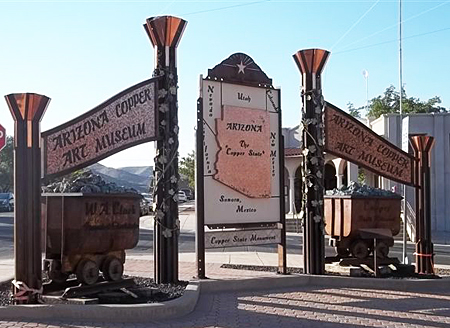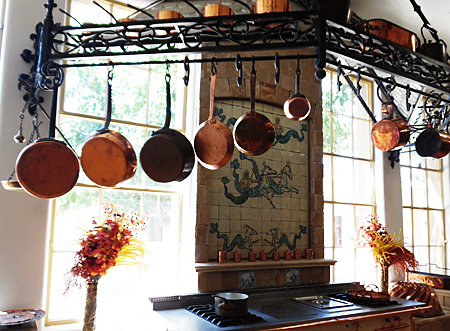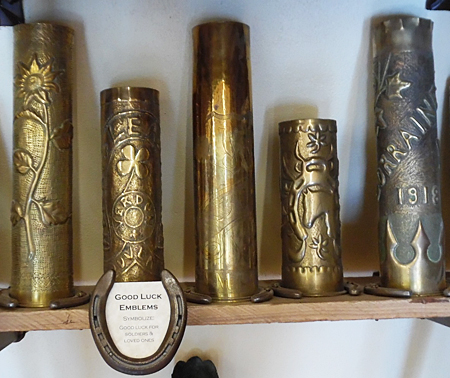The Arizona Copper Museum: Paying Homage to the Country’s Rich Copper Roots
 Front door of the Arizona Copper Museum.
Front door of the Arizona Copper Museum.Photo by Nancy Ballou.
When William Andrews Clark struck Montana gold in 1863, the cash enabled him to become an investor, entrepreneur and millionaire. Two years later, at the World’s Fair in New Orleans, he saw examples of copper ore from Jerome, AZ, and was inspired to buy the United Verde Copper Company. He obtained water rights, began a smelter/town construction project in 1910, and bought 4,000 acres of land four miles outside Jerome. He built a mainline railroad to haul ore.
Today, the site is home to the Arizona Copper Museum, the country’s largest collection of copper artifacts using Arizona copper. The museum pays homage to copper’s rich history in the United States, in Arizona and beyond.
Clark designed, laid out and constructed the first master-planned community in Arizona for the 7,000 employees that worked in the mine and smelter. The homes, commercial businesses, administration center, schools, recreational and cultural facilities, parks, churches and a public pool were extremely modern. Though Clark never lived there, the area was named Clarkdale. In 1998, it was designated a National Historic District on the National Register of Historic Places.
By 1920, the Clarkdale smelter was one of the largest in the world, processing more than 800,000 tons of copper daily. After Clark died in 1925, his family sold the operation to Phelps Dodge and the mining continued until 1953 when the plant closed permanently. Not a drop of viable copper ore remains.
 Copper pots on display at the Arizona Copper Museum.
Copper pots on display at the Arizona Copper Museum.Photo by Nancy Ballou.
Clarkdale now has a building totally dedicated to the metal.
“It was started by my family members,” says Drake Meinke, non-founding curator. “We wanted to make a museum about copper because the subject, information and artifacts are fascinating. In 2002, looking for a place to tell copper’s story led me to Clarkdale, once famous for production of the metal. The empty 40-year-old high school was for sale and purchased for the museum. It required eight years of extensive repairs when coupled with making displays and collecting examples. We wanted to show what had happened to 125 billion pounds of copper mined here and throughout Arizona.”
The museum’s artifacts cross every category, connected by a common thread—Arizona copper.
“Selections purchased through auction houses, estate sales and the Internet are made for their beauty, detail and historic significance, always with the interests of our patrons in mind,” says Meinke. “Information provided tells copper’s significance in the history of Arizona, plus its overall purpose in society.”
A 15’ tall by 11 1/2’ wide copper beer still, originally made in Belgium and once sold to many breweries in the U.S., was shipped from Ohio and stands on the museum’s lawn. The entrance is the high school’s original front door of copper, brass and a bronze door handle. Thin, copper cut footprints glued to the floor, then topped with clear sealant, begin a hallway lined with interesting stories, facts, myths, legends and symbols relating to the metal. A storyboard explains that copper was the first metal discovered and worked on by man, the first metal on the element table and the first metal to be alloyed. Footprints continue guiding to themed rooms.
 Drake Meinke, curator of the Arizona Copper Museum.
Drake Meinke, curator of the Arizona Copper Museum.Photo by Nancy Ballou.
The museum is divided into six categories covering coppers many uses and applications.
The Information Room is filled with charts and graphs depicting locations of copper worldwide and general facts. Meinke gives details of the metal’s connection to Venus, glyphs, Botticelli’s “Birth of Venus” painting and rocks containing copper particles.
“I can tell by looking at an artifact where and when the piece was produced,” he states.
Before nicknamed “The Grand Canyon State,” Arizona was known as “The Copper State” for more than 100 years. From 1932 to 1934, all state license plates were made of solid copper. Vanity plates with copper paint can still be ordered.
Wall-hanging “Museum Morsel” plaques relay interesting tidbits. One tells of a $37,000,000 copper painting by Rembrandt stolen from a Swedish art museum in 2000, then recovered in 2005. Another mentions the discovery of a frozen ancient Otzi The Iceman in 1991 with a copper axe (yew handle), the only prehistoric axe in conjunction with a mummy discovered to date.
In the Military Room, Meinke explains Trench Art. “World War I was fought from the trenches,” he says. “Shells with projectiles were fired until all ammunition was used. This left soldiers with large amounts of free time waiting for resupply trains. Encouraged by commanders and their own boredom, they gathered the spent brass and lead. Melting the lead over campfires, men poured the molten metal into the discharged casings. In the trenches, hammers and punches were the only tools available in quantity. Often making stencils, but sometimes drawing freehand, soldiers punched all around the design to give a raised three-dimensional effect. The process was repetitious and time-consuming. After artwork completion, the lead inside was reheated into liquid and poured out.”
A high percentage of Trench Art from Britain, France and Belgium can be traced to use of raw materials originating in Clarkdale and Arizona. Impressive results rest on numerous shelves with weaponry such as rifles.
Embellishments like cornices from buildings, finely detailed ceiling panels, vases, even whimsical piggy banks show uses of copper in The Art and Architecture Room. Paintings, postcards and a large Carnegie Mansion Dormer from 1899 New York City are featured.
 A series of copper Trench Art artifacts from the early 1900s.
A series of copper Trench Art artifacts from the early 1900s.Photo by Nancy Ballou.
The Religious Art displays statuettes, plaques, crucifixes and icons. Visitors can watch a video and view a copy of a Dead Sea Scroll written on copper for preservation and found inside a cave in Israel, March, 1952.
Shiny pots and pans hang from the Cooking Room ceiling. Shelves hold water kettles and everything necessary for food preparation.
Kitchen items on table tops or counters project the museum’s philosophy. “We have adopted a touch everything policy so many of our exhibits are in the open,” he states. “We want everyone to feel the copper to its fullest. People love that they can pick up and feel the beautiful metal plus its history.”
The Drinking Room has beer steins, tankards, everything from milk churners to ale measures and pitchers.
A large cognac still dominates The Distillery. Tools for the vineyard and winemaking are on the wall, with a winery and brewery adjacent.
Antique candy molds adorn the hallway. In addition to brass horns, the musical cabinet includes an unique all-copper 33 1/3 rpm master once used by record producers as a model for vinyls. Another case lists quantities of copper found in food products such as shellfish (clams, crabs, mussels), seeds/nuts, dark chocolate, raisins, Enfamil, Ensure and wine, with copper utensils in the center and a few examples of jewelry.
In an alcove off the main walkway stands a life-size statue of Bibesia, a Roman goddess. Behind her is an embossed copper wall. On each side are shields/coats-of-arms from Europe.
New artifacts arrive almost daily. The museum recently added a video demonstrating how to hammer a bowl from a single sheet of copper.
The building itself is light and bright, highlighted by many large windows that reveal “America’s Greatest Treasure Is The World’s Most Beautiful.” There are seats throughout for visitors to sit and reflect. Meinke is proud to state, “Original copper ore mined here has come full-circle and is now back home where it started from.”
Resources:
Also in this Issue:
- The Arizona Copper Museum: Paying Homage to the Country’s Rich Copper Roots
- Shahna Lax: Expressing the Sacred Through Copper
- Restoring Copper Heirlooms for Future Generations
- Mary Button: Turning Paintings into Bronze Relief Sculptures
- Larry Frazier Bronze Works on View at Robert Kuo Gallery
